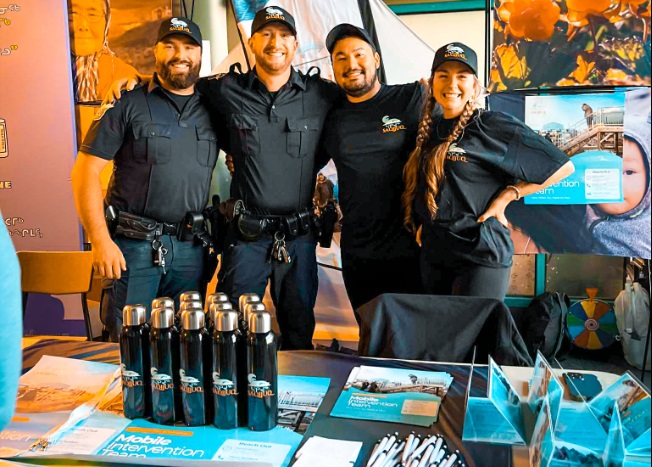The most challenging situations police encounter in Kuujjuaq are crises including threats to children, domestic violence and residents suffering from suicidal ideation. The community now has a new tool for resolving these situations peacefully called the Mobile Intervention Team (MIT), offered by Nunavik community-safety organization Saqijuq. Pairing a police officer with a social worker, the MIT aims to generate peaceful resolutions to complex circumstances. “Where it really shines is [in] de-escalation,” Lukasi Whiteley Tukkiapik told APTN News. Tukkiapik, executive director for Saqijuq, explained that the Kuujjuaq MIT follows a model developed in Puvirnituq, several hundred kilometers away on the Hudson Bay coast. He said that initial version of the MIT, was a “community-based approach to intervention where they had a social worker and a police officer patrolling all night.” After a run-up of planning, hiring, and training, the MIT program came to Kuujjuaq in August. “Let’s say if there’s domestic abuse or other situations like that, they will assist the police officers to help de-escalate the situation, and it really helps with that,” he said. “It also helps the police officers with their intervention. They recognize [social workers’] expertise when it comes to mental health crisis or anything more along those lines. They will let the MIT worker take over and be in charge of the intervention.” Nunavik Police Services vehicle in Kuujjuaq. Photo: APTN file Two social workers in the community do three-week rotations working with police. “They have expertise working within the region as well,” Tukkiapik said. “It’s not an easy job doing crisis intervention day in and day out. Especially when you’re patrolling overnight. And for sure, some of the things that they walk into, they’re not the easiest. So we really targeted people that had a background in crisis intervention and also that knew the reality of the north of Nunavik.” The challenge and necessity of hiring local Saqijuq was unable to hire Inuit for the roles, though as the program develops they hope to hire locals in the future. “They had a hard time hiring local,” he said. “It’s not an easy job doing crisis intervention within your own community. You know the people that are involved. And even if you don’t know the people involved, you know their family.” Suzi Kauki, an advocate for justice and policing reform in Kuujjuaq, recalled that in the 1990s, when the Kativik Regional Police Force (now the Nunavik Police Service) was created, the goal was to have Inuit policing Inuit. “Fast forward to now,” she said, “we have about three to four police officers that are Inuit in the North, and the rest are non-Inuit.” Read more: ‘Policing in Nunavik is broken’: Inuit group wants change after latest fatal shooting 34-year-old man killed in police shooting in Inukjuak: family Kauki said she became involved in policing issues in November of 2020, after Nunavik Police Services, in response to a call from a woman with a rifle in crisis, arrived at the wrong house and instead engaged Kauki’s own two daughters (aged 10 and 11) in a standoff. “That’s when I started to take particular interest in the subject,” she explained, “because I realized that there’s a huge gap between my people and the police that are there to keep us safe.” Kauki speaks warmly of Tukkiapik, and of Saqijuq, whom she called “an amazing team with amazing people.” Saqijuq, she she said, “does amazing culturally-related work, especially within the justice system. And they’ve done very well in training some professionals and taking Inuit out on the land for some healing projects. And they partner with good non-for-profit organizations that also go on the land. So that gives me the confidence.” Nonetheless, Kauki has questions about how the Kuujjuaq MIT will function. To begin with, she noted that the initial iteration of the MIT in Puvirnituq was run by a different organization and in a different manner. “In Puvirnituq, the Inuit were very implicated in the implementation of the project,” she explained. “In Kuujjuaq, it was introduced differently, on social media. They posted on Facebook that there now is a Mobile Intervention Team, and that it’s going to be in Kuujjuaq, and we can call the police officers. But we don’t know them. They’re not Inuit. So I really hope that they’re going to build relationships with Inuit, so they can reach the same objectives as they did in Puvirnituq.” Kauki said the lack of Inuit faces and voices on the team is a concern. As a student at Laval University, she studied the relationship between Inuit and the justice system in Nunavik. She recalled how her research confirmed the 2019 findings of the Viens Commission on systemic racism against Indigenous people in Quebec institutions. “We found that there was a lot of work to be done [in] the relationship between policing and the community,” she said, “that there was a lack of cultural training in the north, and that there is an existence of systemic discrimination within the imposed system up here.” Kuujjuaq is Nunavik’s most populous community and the administrative capital of Kativik Regional Government. Photo: Belug, License CC BY-SA At the core of the problems between Inuit and the justice system, Kauki said, is misunderstanding and misinterpretation. “You can’t even translate justice or judicial words to Inuktitut precisely,” she said. “It’s inexistent, and the only way would be for French or English to convert to our language in order to deliver proper justice. The criminal justice system, as well as the police, have a lot to learn about our culture, our history, our language, and our way of life.” Cultural training is key On that basis, Kauki is a determined advocate for cultural training: she wants to see police officers who speak Inuktitut and understand the culture, beauty, and complexity of the North. But now that the MIT has hired non-Inuit as social workers, she hopes they have the same kind of cultural training. “We need to have better educated police,” she said, “police that understand psychology, police that understand how to deal with crisis situations, but right now that is inexistent. The police that come here, we do not know them. They are not part of the community.” Among those Kauki worries about are the police officers themselves. Coming from the south and arriving in isolated communities where they often don’t understand the context of the situations they encounter, police in Nunavik may struggle with mental health concerns. Kauki said policing cannot occur without a much stronger psychological safety-net for officers, whom she believes need to be taken care of by the justice system. “Unfortunately, when that doesn’t happen,” she said, “you have police officers that end up with mental health disorders, such as depression, anxiety, and the most common one is post-traumatic stress disorder. And extending that to complex post-traumatic stress disorder, because then they’re exposed to many traumatic events.” Kauki said the police officers who arrive in Nunavik from the south are often young. She believes they have good intentions and have taken jobs they feel will help them do good in the world. But she said many police arrive in the north undertrained and lacking support from their employers, as they set out to face complex and tragic situations. “You have to be made of steel to survive that,” she said. “[Police services] have a lot to learn about ensuring that their employees are well protected, and that they have access to resources like therapy, psychologists, [and] psychiatrists. Without that, then you’re endangering an entire nation.” At the same time, Kauki embraces the potential of the MIT initiative to lower police-involved deaths in Nunavik. “There’s the Inuit who are traumatized by the police, who are afraid of the police officers, given the many circumstances that they have lived, and deaths,” she said. “Seventeen [NPS-involved fatalities] since 2017.” The situation on the ground is changing, said Tukkiapuk. While many of the circumstances the original MIT encountered in Puvirnituq involved people under the influence of alcohol, the region is beginning to see greater traffic in cocaine and methamphetamine, both drugs associated with volatile and unpredictable behaviour. “Harder drugs coming into the region [are] really making life much more difficult for people,” he said. “It’s exacerbating the social issues.” Housing issues is another challenge in Nunavik. While there is social housing for residents and housing from organizations that need a place for their employees to live, there’s little housing for the new residents required to expand a program like the MIT. But the plan is for the MIT to slowly grow to other communities as soon as it’s able to. “We’re aiming for next summer to launch a secondary team in another village,” Tukkiapuk said, though he wouldn’t name which community or communities would be next to get crisis-intervention teams. “One of the challenges that we’re going to have to face is to grow, to be able to expand to the other communities, we can only go as far as our funding will allow us.” Continue Reading
Kuujjuaq crisis intervention team aims to help police de-escalate situations

Leave a Comment










